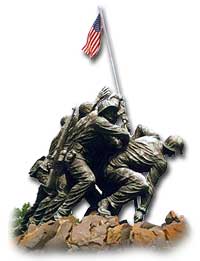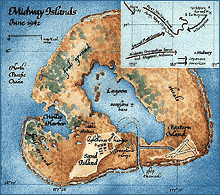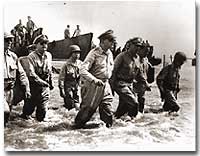51d. War in the Pacific

Located in Arlington, Virginia, this sculpture depicts the raising of the American flag over Iwo Jima and is dedicated to all Marines who have given their life in defense of the United States.
Defeating Germany was only part of America's mission.
Pearl Harbor was only the beginning of Japanese assaults on American holdings in the Pacific. Two days after attacking Pearl Harbor, they seized Guam, and two weeks after that they captured Wake Island. Before 1941 came to a close, the Philippines came under attack.
Led by General Douglas MacArthur, the Americans were confident they could hold the islands. A fierce Japanese strike proved otherwise. After retreating to strongholds at Bataan and Corregidor, the United States had no choice but to surrender the Philippines. Before being summoned away by President Roosevelt, General MacArthur promised: "I shall return."
Before he returned however, the Japanese inflicted the Bataan Death March, a brutal 85-mile forced on American and Filipino POWs. 16,000 souls perished along the way.

The map inset depicts the movements of both the Japanese and Allied forces during the Battle of Midway in June 1942.
In June 1942, Japan hoped to capture Midway Island, an American held base about 1000 miles from Hawaii. Midway could have been used as a staging point for future attacks on Pearl Harbor. The United States was still benefiting from being able to decipher Japanese radio messages. American naval commanders led by Chester Nimitz therefore knew the assault was coming.
Airplane combat decided the Battle at Midway. After the smoke had cleared, four Japanese aircraft carriers had been destroyed. The plot to capture Midway collapsed, and Japan lost much of its offensive capability in the process. After the Battle of Midway, the Japanese were forced to fall back and defend their holdings.

In 1941, Gen. Douglas MacArthur was forced to surrender the Philippines, but made his famous promise of "I shall return." Three years later, he made good on his promise to liberate the islands.
Island hopping was the strategy used by the United States command. Rather than taking every Japanese fortification, the United States selectively chose a path that would move U.S. naval forces closer and closer to the Japanese mainland. In October 1944, MacArthur returned to the Philippines accompanied by a hundred ships and soon the islands were liberated. The capture of Iwo Jima and Okinawa cleared the way for an all-out assault on Japan. Despite heavy losses, the Japanese refused to surrender. They intensified the attacks on American ships with suicide mission kamikaze flights.
In April 1945, President Roosevelt died of a brain hemorrhage, and Harry Truman was unexpectedly left to decide the outcome of the war in the Pacific.






